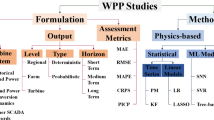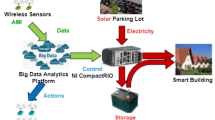Abstract
Forecasting the future energy demand accurately is a critical issue, especially for countries like Turkey where the energy dependency ratio is high. This paper presents a neural network based on the particle swarm optimization algorithm with mutation (PSOM-NN) to enhance the prediction accuracy of the energy demand of Turkey. Unlike some studies in the field which are using all the observed data for training purpose, the proposed network used only a part of these data for training. Approximately 63 % and 37 % of the mentioned data are used for the training and test, respectively. Detrending is applied to the data to avoid nonlinear transfer functions that constrain the model to the input range values. The analysis of the results revealed that PSOM-NN produced better forecasts of energy demand compared to the earlier studies in terms of root-mean-square error, mean absolute percentage error and mean absolute deviation. Finally, future projections under different scenarios are also employed and discussed. It is believed that the proposed model could be applied to any country that needs accurate forecasts of the energy demand for sustainable energy policies.






Similar content being viewed by others
References
International Energy Agency (2013). http://www.iea.org/newsroomandevents/pressreleases/2010/july/name,20287,en.html. Accessed 23 July 2013
Republic of Turkey Prime Ministry (2010) Investment Support and Development Agency of Turkey & Deloitte, Turkish Energy Industry Report
European Commission (2013) Eurostat. http://epp.eurostat.ec.europa.eu/statistics_explained/index.php/The_EU_in_the_world_-_energy#Energy_imports. Accessed 24 April 2013
Suganthi L, Samuel Anand A (2012) Energy models for demand forecasting—a review. Renew Sustain Energy Rev 16(2):1223–1240
Farahbakhsh H, Ugursal VI, Fung AS (1998) A residential end-use energy consumption model for Canada. Int J Energy Res 22(13):1133–1143
Chavez S Gonzales, Xiberta Bernat J, Llaneza Coalla H (1999) Forecasting of energy production and consumption in Asturias (Northern Spain). Energy 24(3):183–198
Ediger VŞ, Tatlıdil H (2002) Forecasting the primary energy demand in Turkey and analysis of cyclic patterns. Energy Convers Manag 43(4):473–487
Yumurtacı Z, Asmaz E (2004) Electric energy demand of Turkey for the year 2050. Energy Sources 26:1157–1164
Ediger VS, Akar S (2007) ARIMA forecasting of primary energy demand by fuel in Turkey. Energy Policy 35(3):1701–1708
Kankal M, Akpınar A, Kömürcü Mİ, Özşahin TŞ (2011) Modeling and forecasting of Turkey’s energy consumption using socio-economic and demographic variables. Appl Energy 88(5):1927–1939
Aydin G (2014) Modeling of energy consumption based on economic and demographic factors: The case of Turkey with projections. Renew Sustain Energy Rev 35:382–389
Ceylan H, Öztürk HK (2004) Estimating energy demand of Turkey based on economic indicators using genetic algorithm approach. Energy Convers Manag 45:2525–2537
Canyurt OE, Ceylan H, Ozturk HK, Hepbasli A (2004) Energy demand estimation based on two-different genetic algorithm approaches. Energy Sources 26(14):1313–1320
Haldenbilen S, Ceylan H (2005) Genetic Algorithm Approach to Estimate Transport Energy Demand in Turkey. Energy Policy 33:89–98
Toksarı MD (2007) Ant colony optimization approach to estimate energy demand of Turkey. Energy Policy 35(8):3984–3990
Ünler A (2008) Improvement of energy demand forecasts using swarm intelligence: The case of Turkey with projections to 2025. Energy Policy 36(6):1937–1944
Kıran MS, Özceylan E, Gündüz M, Paksoy T (2010) A novel hybrid approach based on particle swarm optimization and ant colony algorithm to forecast energy demand of Turkey. Energy Convers Manag 53(1):75–83
Özçelik Y, Hepbaşlı A (2006) Estimating petroleum exergy production and consumption using a simulated annealing approach. Energy Sources B: Econ Plan Policy 1(3):255–265
El-Telbany M, El-Karmi F (2008) Short-term forecasting of Jordanian electricity demand using particle swarm optimization. Electr Power Syst Res 78(3):425–433
Chakravarty S, Dash PK (2011) Dynamic filter weights neural network model integrated with differential evolution for day-ahead price forecasting in energy market. Expert Syst Appl 38:10974–10982
Görücü FB, Geriş PU, Gümrah F (2004) Artificial neural network modeling for forecasting gas consumption. Energy Sources 26:299–307
Sözen A, Arcaklıoğlu E, Özkaymak M (2005) Turkey’s net energy consumption. Appl Energy 81(2):209–221
Sözen A, Akçayol MA, Arcaklıoğlu E (2006) Forecasting net energy consumption using artificial neural network. Energy Sources, Part B: Econ, Plann Policy 1:147–155
Sözen A, Arcaklıoğlu E (2007) Prediction of Net Energy Consumption Based on Economic Indicators (GNP and GDP) in Turkey. Energy Policy 35:4981–4992
Murat YS, Ceylan H (2006) Use of Artificial Neural Networks for Transport Energy Demand Modeling. Energy Policy 34:3165–3172
Hamzaçebi C (2007) Forecasting of Turkey’s net electricity energy consumption on sectoral bases. Energy Policy 35(3):2009–2016
Kavaklıoğlu K, Ceylan H, Öztürk HK, Canyurt OE (2009) Modeling and Prediction of Turkey’s Electricity Consumption Using Artificial Neural Networks. Energy Convers Manag 50:2719–2727
Sözen A, Arcaklioğlu E (2007) Prospects for future projections of the basic energy sources in Turkey. Energy Sources B 2(2):183–201
Sözen A (2009) Future projection of the energy dependency of Turkey using artificial neural network. Energy Policy 37(11):4827–4833
Dibike YB, Solomatine DP (2001) River flow forecasting using artificial neural networks. Phys Chem Earth Part B 26(1):1–7
Geem ZW, Roper WE (2009) Energy demand estimation of South Korea using artificial neural network. Energy Policy 37(10):4049–4054
Pao HT (2009) Forecasting energy consumption in Taiwan using hybrid nonlinear models. Energy 34(10):1438–1446
Ekonomou L (2010) Greek long tern energy consumption prediction using artificial neural networks. Energy 35:512–517
Shiwei Yu, Zhu Kejun, Zhang Xian (2012) Energy demand projection of China using a path-coefficient analysis and PSO–GA approach. Energy Convers Manag 53(1):142–153
Zhang G, Patuwo BE, Hu MY (1998) Forecasting with artificial neural networks: The state of the art. Int J Forecast 14:35–62
Bashir ZA, El-Hawary ME (2009) Applying wavelets to short-term load forecasting using PSO-based neural networks. IEEE Trans Power Syst 24(1):20–27
Dehuri S, Cho SB (2010) A comprehensive survey on functional link neural networks and an adaptive PSO-BP learning for CFLNN. Neural Comput Appl 19(2):187–205
Ata R (2015) Artificial neural networks applications in wind energy systems: a review. Renew Sustain Energy Rev 49:534–556
Shayeghi H, Shayanfar HA, Azimi G (2009) STLF based on optimized neural network using PSO. World Academy of Science, Engineering and Technology 3:889–899
Quaiyum S, Khan YI, Rahman S, Barman P (2011) Artificial neural network based short term load forecasting of power system. International Journal of Computer Applications 30(4):1–7
Banda E, Folly KA (2015) Short Term Load Forecasting Based on Hybrid ANN and PSO. Springer International Publishing, In Advances in Swarm and Computational Intelligence, pp 98–106
Jiang X, Ling H, Yan J, Li B, Li Z (2013) Forecasting electrical energy consumption of equipment maintenance using neural network and particle swarm optimization. Math Probl Eng 2013:1–8. doi:10.1155/2013/194730
Ren C, An N, Wanga J, Li L, Hud B, Shang D (2014) Optimal parameters selection for BP neural network based on particle swarm optimization: a case study of wind speed forecasting. Knowl-Based Syst 56:226–239
Kennedy J, Eberhart RC (1995) Particle swarm optimization. In: Proceedings of IEEE international conference on neural networks, pp 1942–1948
Eberhart RC, Shi Y (2001) Particle swarm optimization: developments, applications and resources, vol 1. In: Proceedings of the 2001 congress on evolutionary computation, pp 81–86
Daş MT, Dulger LC, Daş GS (2013) Robotic applications with particle swarm optimization (PSO). In: 2013 international conference on control, decision and information technologies (CoDIT). IEEE
Gerhard Venter (2003) Sobieszczanski-Sobieski J (2003) Particle swarm optimization. AIAA journal 41(8):1583–1589
Michalewicz Z (1996) Genetic algorithms + data structures = evolution programs, 3rd edn. Springer, Berlin
Higashi N, Iba H (2003) Particle swarm optimization with gaussian mutation. In: Proceedings of the IEEE swarm intelligence symposium, pp 72–79
Stacey A, Jancic M, Grundy I (2003) Particle swarm optimization with mutation. In: Proceedings of the 2003 congress on evolutionary computation. IEEE Press, pp 1425–1430
Esquivel SC, Coello Coello CA (2003) On the use of particle swarm optimization with multimodal functions. In: Proceedings of the 2003 congress on evolutionary computation. IEEE Press, pp 1130–1136
Zhang Q-L, Li X, Tran Q-A (2005) A modified particle swarm optimization algorithm. In: Proceedings of the fourth international conference on machine learning and cybernetics
Andrews PS (2006) An investigation into mutation operators for particle swarm optimization. In: Proceedings of IEEE congress on evolutionary computation, pp 1044–1051
Venkatesan D, Kannan K, Saravanan R (2009) A genetic algorithm-based artificial neural network model for the optimization of machining processes. Neural Comput Appl 18(2):135–140
Sharda R (1994) Neural networks for the MS/OR analyst: An application bibliography. Interfaces 24(2):116–130
Suresh Y (2015) Software fault prediction and test data generation using artificial intelligent techniques. Ph.D. thesis, Department of Computer Science and Engineering, National Institute of Technology Rourkela, India. http://ethesis.nitrkl.ac.in/6704/1/yeresime_phd_2015.pdf
Turkish Ministry of Energy and Natural Resources (2013). www.enerji.gov.tr. Accessed July 2013
Schumann J, Liu Y (2006) Performance estimation of a neural network-based controller. In: Wang J, Yi Z, Zurada JM, Lu B-L, Yin H (eds) Advances in neural networks-ISNN 2006. Springer, Berlin, pp 981–990
Eaves Andrew HC, Kingsman BG (2004) Forecasting for the ordering and stock-holding of spare parts. J Oper Res Soc 55(4):431–437
Peter Zhang G, Qi Min (2005) Neural network forecasting for seasonal and trend time series. Eur J Oper Res 160(2):501–514
Lind Douglas A, Marchal William G, Wathen Samuel A (2012) Statistical techniques in business and economics, 15th edn. McGraw-Hill, New York
Taskaya-Temizel T, Casey MC (2005) A comparative study of Autoregressive Neural Network Hybrids. Neural Networks 18(5–6):781–789
Author information
Authors and Affiliations
Corresponding author
Rights and permissions
About this article
Cite this article
Daş, G.S. Forecasting the energy demand of Turkey with a NN based on an improved Particle Swarm Optimization. Neural Comput & Applic 28 (Suppl 1), 539–549 (2017). https://doi.org/10.1007/s00521-016-2367-8
Received:
Accepted:
Published:
Issue Date:
DOI: https://doi.org/10.1007/s00521-016-2367-8




